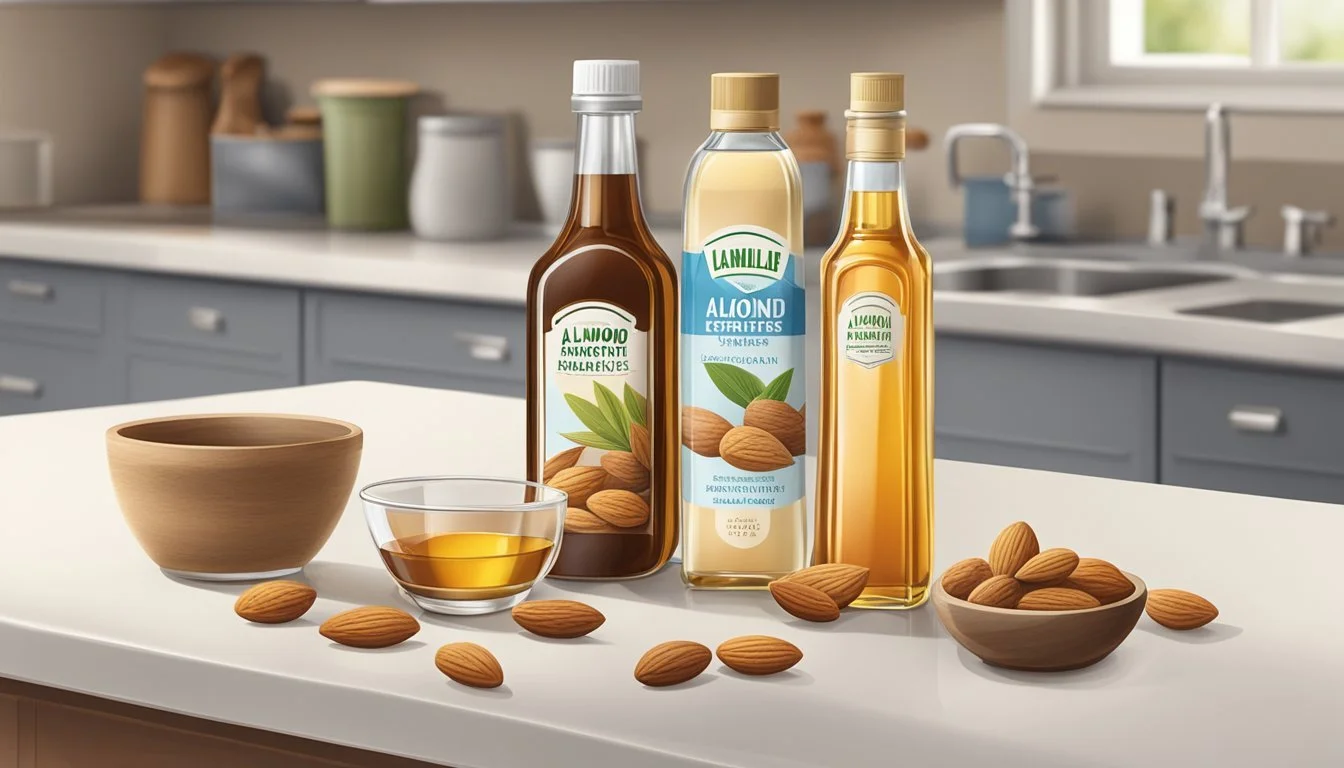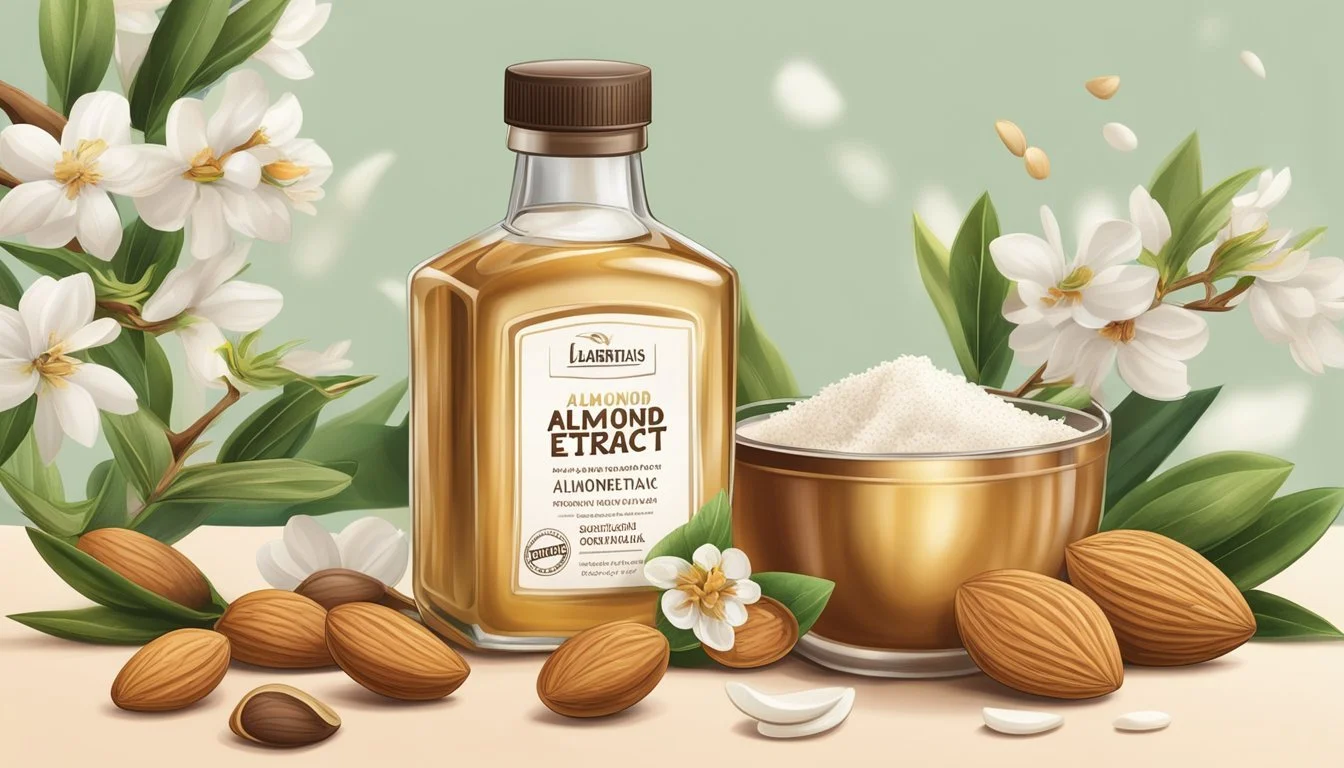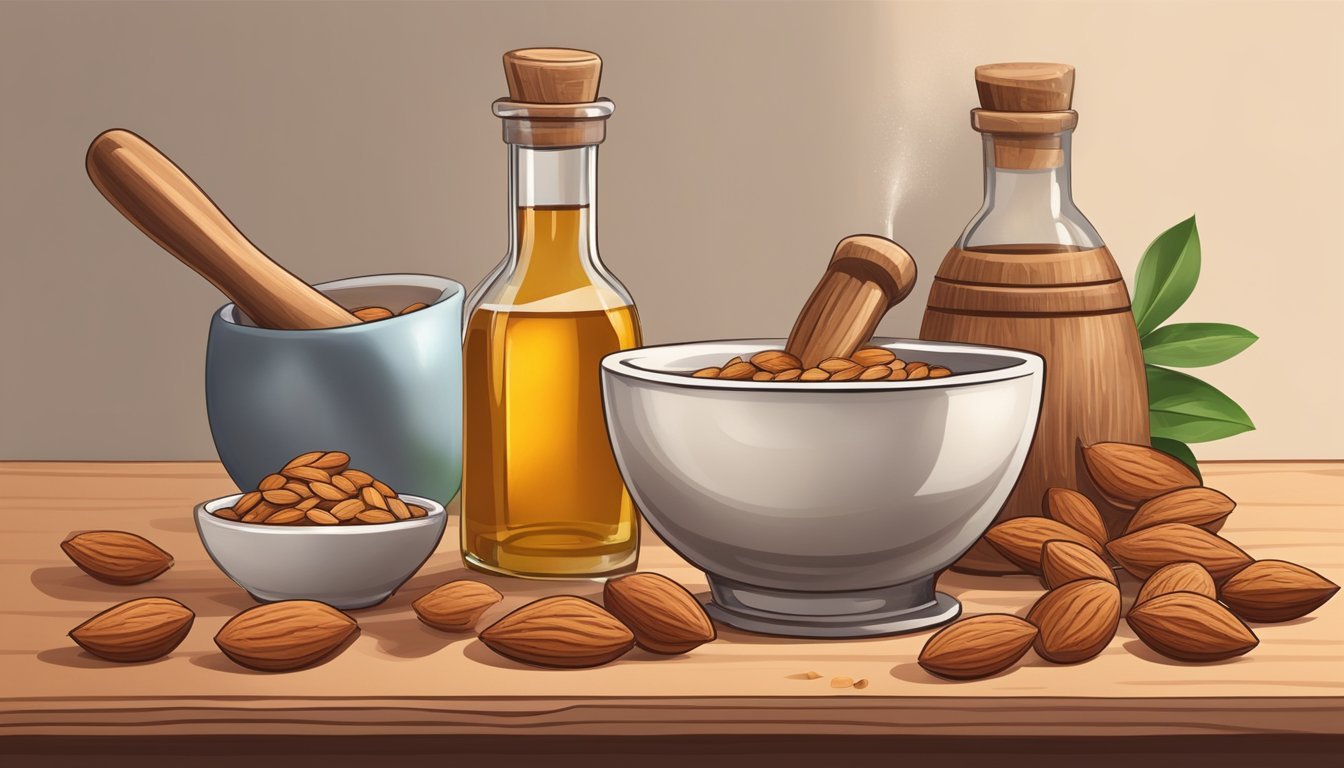Almond Extract Substitutes
Top Alternatives for Baking and Cooking
Almond extract is a concentrated liquid used to impart the nutty flavor and aroma of almonds to various recipes, particularly in baked goods like cookies, cakes, and pastries. This extract is made by combining almond oil with ethyl alcohol, resulting in a potent ingredient where a little goes a long way. However, when almond extract is not available or suitable for certain dietary restrictions or flavor preferences, cooks may seek alternatives to achieve a comparable taste profile in their dishes.
Several substitutes can be used in place of almond extract, each offering a distinct flavor that can complement the intended recipe. Vanilla extract is often used as an alternative due to its wide availability and similarly sweet and aromatic qualities, even though it lacks the nutty essence of almond extract. Orange zest or juice can also be utilized, providing a fresh citrus note that can brighten the flavors of a dish. Other substitutes like walnut extract or cinnamon can be employed for their warm, earthy characteristics, though they will not replicate the exact flavor profile of almond extract. When selecting an alternative, it is important to consider the flavor compatibility with the other ingredients and the intended outcome of the recipe.
Understanding Almond Extract
Almond extract is a culinary ingredient known for its potent, sweet, and distinctly nutty flavor. It is commonly used to enhance the taste of various baked goods and desserts (What wine goes well with desserts?).
Origins and Production
Almond extract is derived from almonds, either through the process of steeping crushed almonds in alcohol or by synthesizing benzaldehyde, which gives the extract its signature flavor. Natural almond extract is made from real almonds, usually bitter almonds, which offer a more intense flavor due to a compound called benzaldehyde. The process typically involves:
Selecting quality almonds
Crushing and soaking them in an alcohol solution
Distilling the mixture to intensify the flavor
Homemade almond extract can be made by steeping crushed almonds in alcohol over several weeks.
Common Uses in Baking and Cooking
Almond extract is highly concentrated and is therefore used sparingly in recipes. It provides a robust, sweet, and nutty flavor profile that is ideal for:
Desserts: Enhancing the taste of cookies, cakes, and pastries.
Baked goods: Used in both sweet and savory baked goods.
Almond essence: Sometimes referred to as almond essence, it's used to imbue a variety of recipes with almond flavor.
A few drops can transform a simple recipe into something with depth and distinction. Almond extract is versatile enough to complement other ingredients, allowing chefs and bakers to achieve the desired flavor complexity in their creations.
Why Substitute Almond Extract?
When baking or cooking, one might need to replace almond extract due to allergies, cost or availability issues, or a preference for a different flavor profile.
Allergies and Dietary Restrictions
Individuals with nut allergies, including allergies to almonds, require a substitute for almond extract to avoid the risk of allergic reactions. Almond extract is derived from bitter almonds and can trigger a severe allergic response. For those with allergies, options like vanilla extract or fruit zests offer safe alternatives that mimic the nutty flavor without the health risks.
Availability and Cost
Almond extract might not be readily available in every pantry or in certain regions. It can also be relatively expensive compared to other extracts. For practical reasons, home cooks often seek more common or cost-effective substitutes that can be found in the kitchen like vanilla extract or cinnamon, which can provide a similar depth of flavor when used in the right proportions.
Desire for Different Flavors
Some may seek to substitute almond extract to experiment with flavor profiles or complement other ingredients in a recipe. Almond extract has a distinct taste that might clash with certain flavors, whereas substitutes like orange zest or brown butter can offer a more harmonious flavor combination, especially in non-fruity desserts or when mixed with delicate ingredients such as almond milk.
Substitute options must be chosen carefully to achieve the desired outcome while respecting dietary restrictions, managing costs, and ensuring ingredient compatibility.
Popular Almond Extract Substitutes
Almond extract is a staple in many baking recipes, but there are several effective substitutes that can mimic or complement its sweet, nutty flavor. Substitutions can vary based on the desired outcome in flavor and the type of recipe.
Vanilla Extract
Vanilla extract serves as a readily available alternative to almond extract. Though milder, its sweet and intricate flavor makes it a versatile substitute. To adjust for its subtler taste, it is recommended to use a ratio of 1.5 teaspoons of vanilla extract for every teaspoon of almond extract.
Amaretto
Amaretto, an almond-flavored liqueur, provides a depth of flavor with a hint of sweetness and complexity. Due to its alcoholic content, it should be used sparingly. Generally, using 2 to 4 teaspoons of amaretto is equivalent to 1 teaspoon of almond extract.
Nut Extracts
Other nut extracts, such as walnut, hazelnut, and pecan extracts, can also substitute for almond extract. Their distinctive, nutty profiles offer a compatible flavor, especially in baked goods and desserts. Use them in a 1:1 ratio when replacing almond extract.
Walnut extract is warm and rich.
Hazelnut extract carries a toasty and robust taste.
Pecan extract adds a buttery and sweet note.
Fruit Zests and Juices
Citrus zest, like orange and lemon zest, adds freshness and a citrusy kick that can brighten recipes in place of almond extract. A direct substitute would involve using 1 teaspoon of zest for every teaspoon of almond extract. Furthermore, fruit juices—particularly cherry juice or maraschino cherry juice—offer a fruity sweetness. They should be used in small amounts, with a recommended measure of 1 teaspoon of juice as a starting point for substitution.
Making an Impact with Spices
In the quest for the perfect almond extract substitute, certain spices stand out for their rich flavor profiles. They provide unique tastes that can enhance the complexity of desserts without overshadowing other ingredients.
Cinnamon
Cinnamon offers a warm, aromatic flavor that is versatile across various dessert recipes. Typically used in baking, one can leverage its sweet and woody notes to replace almond extract.
Ratio: For every 2 drops of almond extract, use 1/2 teaspoon of cinnamon.
Nutmeg
Nutmeg has a distinct, pungent flavor with subtle sweetness and is often used in spice blends. Its flavor profile makes it a suitable substitute for almond extract in dessert recipes where a nutty essence is desired.
Best for: Desserts that benefit from a warm, spicy kick.
Usage: Use sparingly, as nutmeg's flavor is quite potent.
Allspice
Allspice, despite what its name suggests, is a single spice with a flavor reminiscent of cinnamon, nutmeg, and cloves combined. It offers a rounded depth to desserts that require a complex spice profile.
How to use: Start with a small amount and adjust according to taste, as its intensity can easily dominate.
Non-Alcoholic Alternatives
When seeking an almond extract replacement without alcohol, cooks have several practical options ranging from other non-alcoholic extracts to different flavor enhancers.
Extracts Without Alcohol
Vanilla Extract: A common pantry staple, vanilla extract can replace almond extract due to its aromatic similarity. One should use 1.5 teaspoons of vanilla extract for each teaspoon of almond extract to achieve the desired flavor.
Imitation Almond Extract: An alcohol-free option, imitation almond extract is manufactured to mimic the taste of almond extract. It's available in a concentrated form and can be used in a one-to-one ratio.
Other Flavor Enhancers
Almond Milk: For those looking to infuse a mild almond flavor without using alcohol-based products, almond milk can serve as an alternative, particularly in recipes where a liquid component is required.
Vanilla Bean Paste: A more concentrated product than vanilla extract, vanilla bean paste contains the seeds from the vanilla pod, offering an intense vanilla flavor that can complement dishes similarly to almond extract.
Homemade Almond Extract: By infusing non-alcoholic liquid with almond essence or maraschino cherries, one can create a homemade almond extract substitute. This method allows for customization of flavor strength.
Homemade Substitutes for Almond Extract
For those looking to replicate the sweet, nutty flavor of almond extract, homemade alternatives can be made using readily available ingredients. The DIY approach allows control over flavor intensity and ingredient quality.
DIY Almond Extract
In creating a homemade almond extract, one needs vodka and raw, unsalted almonds. The process involves a steeping technique where the almonds infuse the vodka with their essential flavors. A basic ratio to follow is one part almonds to two parts vodka, such as 1 cup of vodka to ½ cup of almonds. The mixture should rest in a sealed jar, away from direct sunlight, for at least a month, allowing the flavor to develop.
Ingredients:
½ cup raw almonds
1 cup vodka
Instructions:
Chop or crush the almonds to increase surface area.
Combine with vodka in a jar with a tight lid.
Store in a cool, dark place, shaking occasionally.
After 4-6 weeks, strain the almonds from the mixture.
Using Different Nuts and Stones
When almonds are not an option, one can replace them with similar nuts or even fruit stones. Apricot kernels and peach stones have a distinctly almond-like flavor and can be used as substitutes in a homemade extract. Almond butter, though not used for making extract, can impart almond flavor in some recipes.
Apricot kernels and peach stones:
Clean and crush the kernels or stones.
Follow the same steeping process as with almonds.
Nuts and stones alternatives:
Alternative Flavor Profile Note Apricot Kernels Almond-like Aromatic, natural substitute with similar compounds Peach Stones Nutty, sweet Adds depth with a fruity undertone
One should bear in mind that raw apricot kernels and peach stones contain amygdalin, which can produce cyanide when metabolized, so their use should be approached with caution and in moderation. It is recommended to research and follow safe handling practices when using these as substitutes.
How to Choose the Right Substitute
Choosing an appropriate almond extract substitute depends on the nature of the recipe and desired outcome. One must consider the recipe's complexity, the substitute's flavor profile, and the impact on texture and aroma.
Considering the Recipe
When selecting a substitute for almond extract, it's crucial to consider the specific recipe. Desserts like cakes and cookies often require a distinct almond flavor, so one should opt for a substitute that provides a similar nuance. Vanilla extract, for instance, offers a subtly sweet and rich taste, although it's milder; therefore, a 2:1 ratio is recommended when replacing almond extract. The type of dessert, whether it be muffins or pastries, can also dictate the choice of substitute, as some alternatives may alter the final product's flavor balance or texture.
Understanding Flavor Profiles
A successful substitute not only mimics almond extract's flavor but also complements the other ingredients. Almond extract has a sweet and nutty taste, and while vanilla extract is the most common alternative, options like walnut extract can maintain the nutty essence. For recipes where nuttiness is less critical, citrus zests, such as orange zest, contribute a fresh and tangy note, while cinnamon adds warm and earthy undertones.
Accounting for Texture and Aroma
Texture and aroma are significant factors in baking. An effective substitute for almond extract should align closely with the original ingredient's viscosity and scent profile to avoid altering the dessert's structure. Brown butter can serve as a direct one-to-one substitute, offering a comparable aroma without compromising the baked good's texture. However, one should be cautious with drier substitutes like spices, which may necessitate an adjustment in liquid content elsewhere in the recipe to maintain the proper texture.
Substitution Ratios and Tips
When a recipe calls for almond extract, and one needs to use a substitute, getting the quantity and balance right is key to maintaining the intended flavors of the dish.
Determining Quantities for Substitutes
Vanilla Extract: For every teaspoon of almond extract, use 1.5 teaspoons of vanilla extract. Vanilla is less potent and has a milder flavor.
Brown Butter: Replace almond extract with brown butter in a 1:1 ratio. Brown butter should be cooled before adding to the mixture.
Cinnamon: Half a teaspoon of cinnamon is sufficient for replacing two drops of almond extract. It provides earthy and nutty tones, similar to almond extract.
Citrus Zest: Use orange zest to substitute almond extract without needing to alter ratios, as this relies much on personal taste preference.
Tips for Successful Baking Substitutions
Account for Potency: Substitutes can have a stronger or milder effect on the recipe. Adjust quantities based on the potency compared to almond extract.
Consider Alcohol Content: Homemade almond extract substitutes using vodka need to consider the alcohol content in the final flavor profile of the baked goods.
Follow Instructions: Respect the specific instructions associated with each substitute to ensure the desired outcome in the recipe.
Test and Taste: Small test batches are advisable when trying out new substitutes to gauge the success of the substitution before committing to the full recipe.
Dealing with Nut Allergies
When cooking or baking for individuals with nut allergies, it's crucial to find suitable substitutes for almond extract that don't compromise flavor but ensure safety.
Nut-Free Substitutes
For those with nut allergies, seeking nut-free substitutes for almond extract is essential. One can opt for fruit-based alternatives that imitate the sweet, fragrant profile of almond extract. For example:
Vanilla Extract: A common and versatile substitute, use a 1:1 ratio.
Fruit Zests: Orange or lemon zest can provide a fresh, citrus note, often suitable when almond extract is a minor ingredient.
Alternatively, if a recipe only calls for a small quantity of almond extract, one might choose to omit it entirely without significantly altering the dish's outcome.
Understanding Nut Allergens
Almond extract generally comes in two forms: pure and imitation. Pure almond extract is derived from the oil of bitter almonds and should be avoided by those with almond and tree nut allergies due to its direct derivation from nuts.
Imitation almond extract, however, is often nut-free as it is usually made from synthetic flavors. Still, individuals should read labels carefully to ensure that the product is truly free of nut derivatives. Ingredients to look for and avoid include:
Water, alcohol, and bitter almond oil.
Almond oil, even in "almond flavoring" products.
By selecting the right substitute and understanding labels, one can safely enjoy the richness of flavors in nut-free cooking and baking.
Cooking and Baking Without Almond Extract
When almond extract is unavailable or unsuitable for dietary reasons, cooks and bakers can utilize various substitutions that provide a complementary flavor profile in both savory and sweet dishes.
For Savory Dishes
In savory preparations, almond extract is less common but can still play a pivotal role in adding a nuanced depth to certain dishes. Substitutions must therefore be carefully considered to maintain the dish's integrity. One such option is vanilla extract, which can provide a subtle and aromatic sweetness. Although less intense, vanilla extract can often fulfill the same background notes that almond extract would supply.
Recommended ratio: Use 1.5 teaspoons of vanilla extract for every teaspoon of almond extract.
Additionally, incorporating orange zest offers a fresh and bright dimension to savory dishes, especially where a lighter citrus note is appropriate.
Recommended ratio: Swap 1 teaspoon of almond extract with 1/2 teaspoon of orange zest.
For Sweet Treats
Sweet recipes traditionally depend on almond extract for its potent and distinctive flavor. It is particularly integral in desserts like cookies, cheesecakes, and cherry pie.
For cookies and breads that require a subtle touch of almond-like warmth, vanilla extract remains a versatile substitute.
For a stronger flavor similarity, consider using almond-flavored liqueurs where applicable, keeping in mind that any alcohol content will typically cook off during baking.
Recommended ratio: Match the amount of almond extract called for with the almond-flavored liqueur.
For recipes such as cheesecakes and cherry pies that demand a more pronounced flavor, orange zest can impart a complementary contrast to the sweetness of these desserts.
Recommended ratio: Half a teaspoon of orange zest can replace 2 drops of almond extract.
In each case, it's essential for bakers to adjust the quantity based on the desired intensity of flavor and the specific recipe requirements.
FAQs and Troubleshooting
When exploring almond extract substitutes, bakers often encounter questions regarding appropriate alternatives and how these substitutes can impact their recipes. This section addresses common inquiries and potential issues to ensure the chosen substitute serves as an effective flavor enhancer.
Common Questions
What can I use if I don't have almond extract?
Vanilla Extract: An accessible and popular choice that provides sweetness and aromatic depth similar to almond extract.
Amaretto: An almond-flavored liqueur that adds a nutty taste with a hint of sweetness, suitable for many recipes requiring almond extract.
Citrus Zest (e.g., Orange Zest): Offers a fresh, tangy twist to recipes and can provide a complimentary flavor profile where almond extract is called for.
Imitation Almond Extract: Mimics the flavor of almond extract and is a direct substitute often available in grocery stores.
How do I substitute almond extract in recipes?
In most cases, substitute almond extract with a 1:1 ratio of vanilla extract for a similar sweetness.
With stronger substitutes like Amaretto, start with half the amount and adjust to taste.
Substitution Challenges
Maintaining Flavor Balance: Substitutes can alter the intended taste of a recipe. When using an alternative like Cinnamon or Chocolate, start with smaller quantities and adjust as needed to avoid overpowering the dish.
Texture and Consistency Concerns: Some liquid substitutes may change the texture of baked goods. For instance, using Maraschino Cherry Juice instead of almond extract might introduce additional moisture. It's crucial to consider these consistencies when altering ingredients.
Beyond Baking: Other Uses of Almond Extract Substitutes
Almond extract substitutes are versatile and can be used to enhance the flavor of beverages and confections, providing a depth of flavor that complements various recipes.
Beverages
When it comes to beverages, vanilla extract stands as a popular almond extract substitute. It can be used in coffee to add a subtle sweetness and depth, enhancing the drink's overall profile. One might add half a teaspoon of vanilla extract to a cup of coffee as a starting point.
For alcohol-based drinks, orange zest can bring a fresh and citrusy note, making it especially suitable for cocktails. A light grating of orange zest over the cocktail can significantly change the dynamics of its flavor.
Confections and Candies
In confections and candies, nut extracts, like walnut extract, can be employed in lieu of almond extract to provide a similar warm, nutty flavor. In recipes calling for almond extract, it can be a direct one-to-one substitute, but personal taste should guide the exact quantities used to avoid overpowering other flavors.
Cinnamon is another useful substitute, offering a warm and spicy undertone to candies. It's especially beneficial in recipes where a more complex flavor profile is desired without competing with other ingredients. Utilizing half a teaspoon of cinnamon can replace every two drops of almond extract typically required in recipes for confections.
Almond Extract and Health Considerations
When discussing almond extract from a health perspective, it is important to consider both its nutritional impact and any potential risks associated with its use, especially for individuals with dietary restrictions or allergies.
Diet and Nutrition
Almond extract is used primarily as a flavoring agent, and thus its direct contribution to nutrition is minimal. However, it is derived from almonds, which are nutritious in their raw form, providing healthy fats, protein, and fiber. Almond milk, a related product, is often fortified with vitamins and minerals, making it a nutritious substitute for dairy milk for those looking for non-dairy alternatives.
Potential Risks
The primary concern with almond extract is its potential as an allergen. Almond allergies are part of the tree nut allergy group, which is one of the most common food allergies. Symptoms can range from mild to life-threatening. Allergic reactions can occur from ingesting even a small amount of the extract or inhaling its aerosolized particles.
Another ingredient in almond extract is benzaldehyde, a compound also found in bitter almond oil, which can be toxic in high amounts. Commercially available almond extract has a regulated amount of benzaldehyde, making it safe for consumption in typical culinary uses. However, individuals should be aware and use the extract as directed.
Conclusion
When replacing almond extract in recipes, cooks have several viable alternatives that maintain a desirable flavor profile. A common and readily available option is vanilla extract, which, although milder, can be utilized in a larger quantity to achieve a similar depth of flavor.
For a citrusy zest, orange zest provides a fragrant substitution, adding a fresh and slightly tang character to dishes. The suggested ratio is 1/2 to 1 teaspoon of orange zest per teaspoon of almond extract. In the realm of nutty essences, walnut extract stands as a warm, palatable choice, though it possesses a distinctive taste compared to almond.
Those seeking an alcoholic alternative with a richer, more complex profile might opt for Amaretto liqueur. This adds a nuanced, sweet, and nutty character with undercurrents of apricot.
Table: Almond Extract Substitutes and Ratios
Substitute Ratio to Almond Extract Notes Vanilla Extract 1.5:1 Milder; use more to mimic almond's intensity Orange Zest 0.5-1:1 Fresh, citrusy aroma Walnut Extract 1:1 Warm, nutty flavor, different from almond Amaretto To taste Sweet, nutty, with apricot undertones
For the home cook, making homemade almond extract is an option. This involves steeping almonds in a base alcohol over a period, resulting in a customized extract strength. It's worth noting that alternatives should be chosen based on the desired outcome of the dish, considering how each substitute's flavor and aroma can uniquely influence the recipe.














